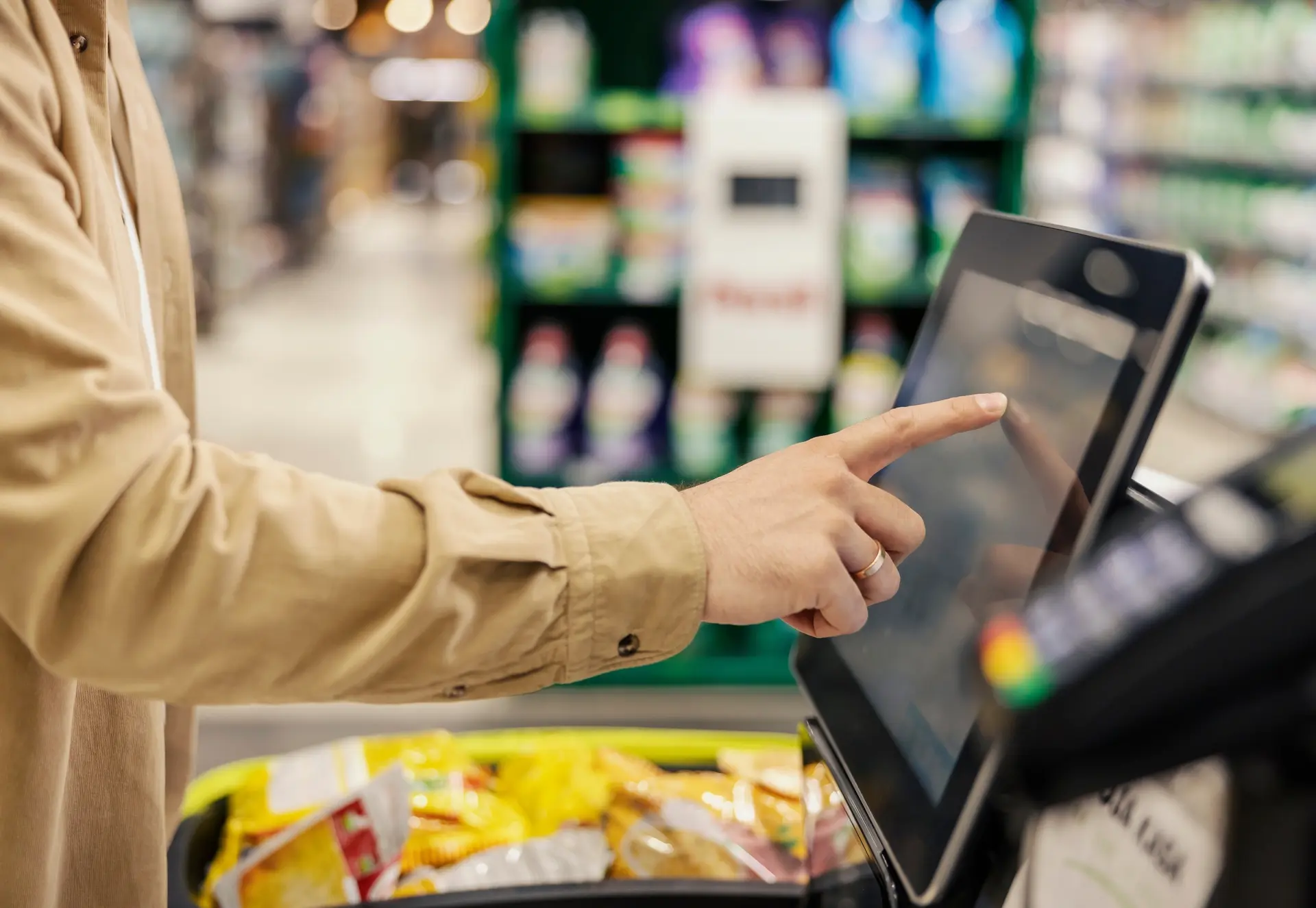
Top 5 Checkout Technology Trends in 2024
May 10, 2024
Technology is progressing at a breakneck pace, and with it, the shopping experience is evolving rapidly. From self-checkout systems that scan barcodes and RFID tags to AI-driven checkout, innovations like Amazon Go’s Just Walk Out and intelligent shopping carts are reshaping how we shop. Let’s explore the benefits and challenges presented by these cutting-edge checkout technologies.
Barcode Scanning Self-Checkout with Manual Item Selection
Self-checkout has become common in many retail stores. Customers can scan product barcodes or select items from a list on the screen for self-checkout, allowing stores to reduce manpower by assigning just one person to manage two or three self-service counters.
However, this form of self-checkout has its drawbacks.
For consumers, the time spent on self-checkout may not necessarily be shorter. Although scanning barcodes is not difficult, it takes a lot of time to scan each item, especially for items without barcodes, such as freshly baked bread, where consumers need to spend extra time understanding the interface and searching for the item in the list.
When multiple consumers encounter problems with self-checkout and seek assistance from store staff simultaneously, staff may be overwhelmed, and it may lower customer satisfaction.
With AI joining the ranks of checkout technology, we can expect self-checkout to become smarter and more efficient. The synergy between “AI image recognition technology” and “self-checkout” will be shared at the end of this article.
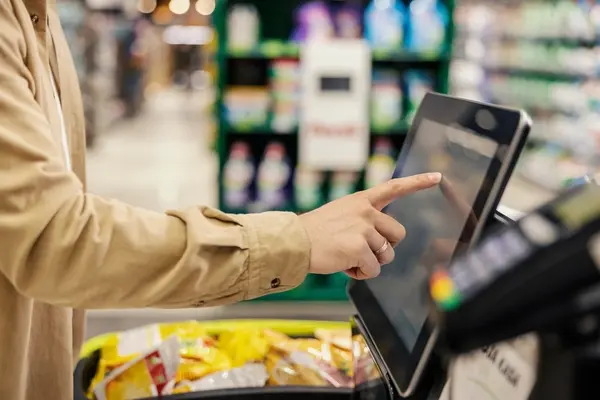
RFID Self-Checkout
RFID technology brings a faster and more convenient shopping experience. Consumers simply place RFID-tagged items in the sensing area, and the system will identify them and list them for consumer confirmation before checkout. This process is simple and can effectively avoid missed scans.
However, this technology requires time and manpower to attach RFID tags to each item, and each RFID tag itself incurs costs. Therefore, RFID checkout is currently used mainly by fashion brands with higher unit prices, such as Decathlon and UNIQLO. H&M and ZARA use RFID tags to track the location of items in-store and manage inventory in real-time.1
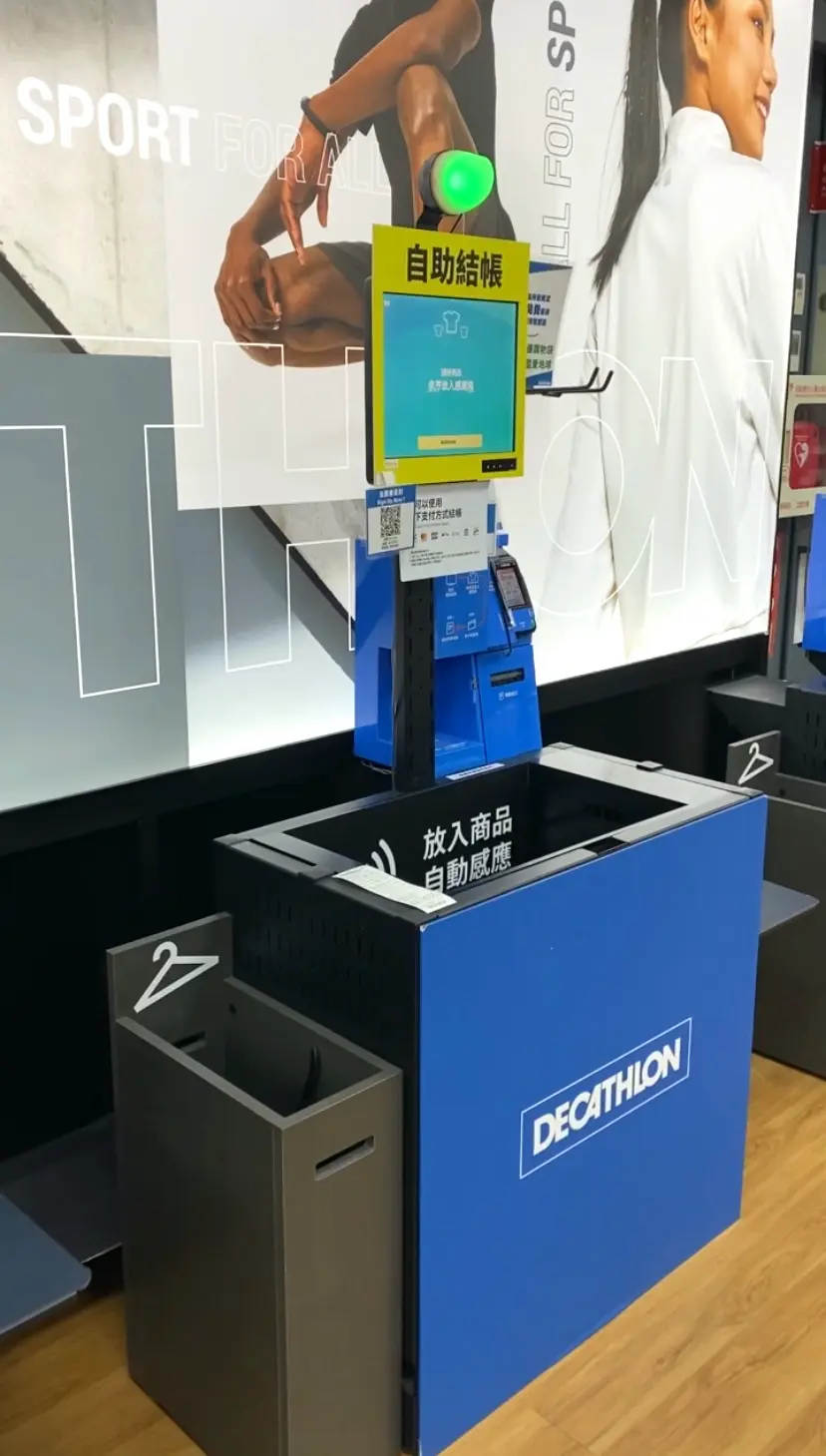
Amazon Go – Just Walk Out
Amazon Go’s Just Walk Out technology is hailed as a game-changer in retail.
Customers need to register with the Amazon App on their phones before entering the store. Some Amazon Go stores allow customers to enter using a credit card or Amazon One at the entrance.2 The system uses cameras throughout the store and weight sensors on the shelves to determine which items customers take. Customers can then leave directly, and after a period, see the amount charged and the receipt in the app on their phones. This article mentions your favorite at super low prices. Choose from same-day delivery, drive-up delivery or order pickup.
While Just Walk Out provides an easy way to shop, it faces several practical challenges, notably high setup and maintenance costs. Moreover, the operational complexity of Just Walk Out makes it hard to scale and expand effectively. For consumers, the requirement to register as Amazon Go members may be inconvenient and could deter those who prefer not to register or who don’t have a credit card from entering the store.
Amazon Go, which debuted in 2018, once stirred up a buzz but eventually closed nine stores in 2023 3. In April 2024, it announced the removal of the Just Walk Out technology in its own Amazon Fresh grocery stores, opting instead for the Amazon Dash Cart.
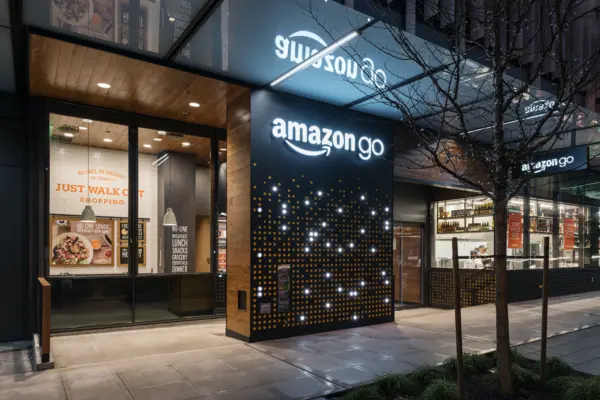
Amazon – Dash Cart
The delayed display of checkout details in Just Walk Out creates a sense of insecurity for many consumers.4 Additionally, the high upfront investment and maintenance difficulties of Just Walk Out have prompted Amazon to reassess their strategy for the future development of this technology.
In light of this, Amazon has replaced Just Walk Out with Amazon Dash Cart at Amazon Fresh supermarkets. Similar to Amazon Go, customers must first register with the Amazon App before using the cart. Then, for each item chosen, customers scan the barcode using the cart’s built-in scanner to log the item, which then displays its price and any promotions, just like an offline “shopping cart”.
If an item does not have a barcode, like bakery items, fruits or vegetables, customers need to enter the PLU (Price Look Up) code manually on the cart screen to record it accurately. Upon leaving the supermarket, customers can directly exit through the lane for carts, and the shopping record will be shown in the app on their phones.5
Actually, this approach simply integrates the steps of “scanning barcodes” and “entering product codes” into the shopping journey.
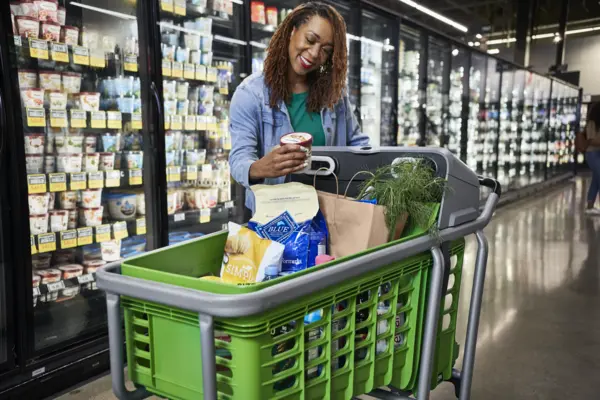
AI-powered Visual Checkout
AI image recognition opens up new possibilities for checkout.
AI can quickly and accurately recognize various products without relying on barcodes or RFID tags, not to mention the need for manual entry of product codes. AI can recognize items like unpackaged bread, cakes, and meals, further improving checkout efficiency and convenience while saving the training time and cost for store staff to identify barcode-less products.
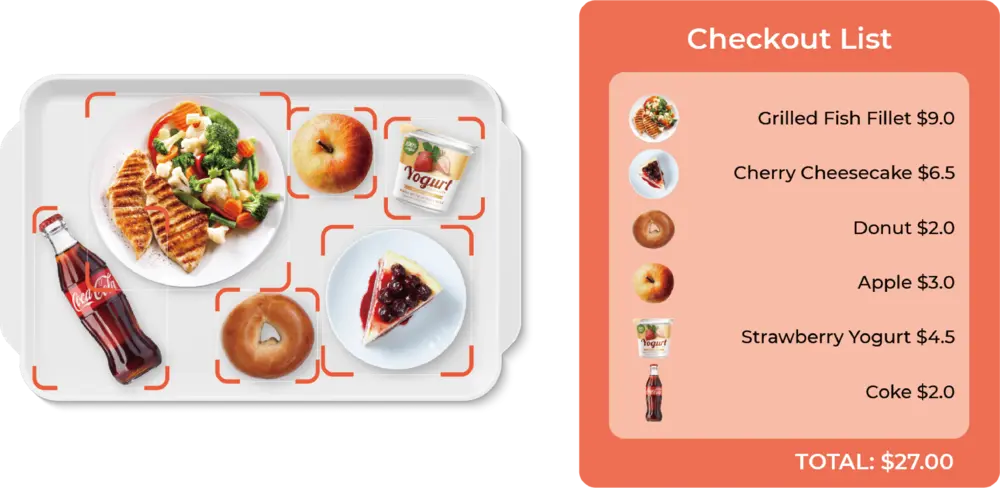
In recent years, startups dedicated to developing AI image recognition checkout solutions have emerged worldwide. The most lightweight solution known to date is in Taiwan. By simply setting up a Viscovery camera and a tablet with Viscovery AI software at the checkout counter, the AI system can get started right away.
Besides, the AI system can be seamlessly integrated with the store’s existing POS checkout terminal by either plug-and-play or through API integration.
In terms of the usage, this AI system can be used by both cashiers (cashier assisted checkout) and consumers (self-checkout).
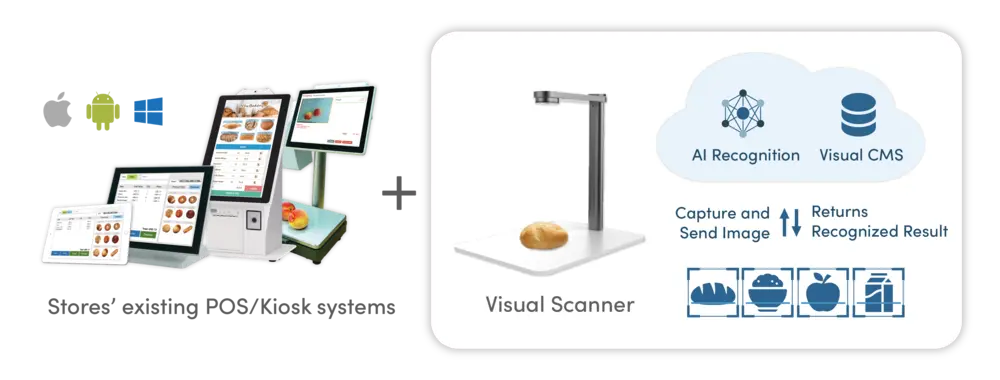
(Image by Viscovery)
Furthermore, there are more possible applications other than checkout, such as inspection before the delivery of meal.
For example, assisting restaurants in conducting “meal inspections” before delivering takeout orders. Since the outbreak of the pandemic, food delivery platforms have risen, bringing convenience to both restaurants and consumers, but occasionally, there are incidents of incorrect orders being delivered. Now, businesses are considering using AI image recognition for a secondary confirmation after employee inspection.
The Viscovery AI system is currently in use at several establishments, including bakery chains like I Jy Sheng and RT Baker House in Taiwan, the Hi Noodle noodle shop under the Haidilao hot pot chain in Singapore, a micromarket within a department store in Sendai, Japan, as well as at THE BAKE STORE and U-o no mori pastry shop in Japan.
This AI system has facilitated over 7 million transactions, comprising more than 38 million items. These instances underscore the extensive adoption of Viscovery AI image recognition technology across the retail and hospitality sectors, with ongoing exploration of its potential in retail settings.
The Viscovery AI system has been used for over 7 million transactions, covering more than 38 million items. These examples show how widely this technology is used in stores and restaurants, and it will keep being used in different ways in the future.
Nowadays, businesses are actively enhancing their services with AI. In sectors like retail and hospitality, checkout is no longer limited to self-service options; there are now more choices available. For shoppers who prefer interacting with staff and value personalized service, AI can assist cashiers in expediting checkout instead of replacing them, remaining human touch. For shoppers who prefer self-checkout can utilize AI image recognition technology to effortlessly identify items even without barcodes, eliminating the need to search through lists. The integration of AI streamlines processes while still maintaining human service, enhancing the overall shopping experience.
To learn more about Viscovery’s Visual Checkout, please visit Visual Checkout.

(Image by Viscovery)
(Featured image: Photo by Shutterstock)
[References]
1 “H&M Gains as Retailer Shows Early Progress Toward Turnaround.” SML Group, https://www.sml.com/hm-gains-as-retailer-shows-early-progress-toward-turnaround/.
2 “Shopping at an Amazon Go Store.” Amazon.com, Inc., https://www.amazon.com/gp/help/customer/display.html?nodeId=GQKJHZZQDJBQN2QF.
3 Bitter, Alex. “Amazon has closed 9 of its Go stores as part of a strategy overhaul. Here’s the full list.” Business Insider, 24 June 2023, https://www.businessinsider.com/amazon-go-stores-closing-nyc-san-francisco-seattle-2023-3.
4 Associated Press. “Amazon says it is removing Just Walk Out technology from its Fresh grocery stores.” npr.org, 3 April 2024, https://www.npr.org/2024/04/03/1242448552/amazon-remove-walk-out-technology.
5 楊又肇 (Mash Yang). “亞馬遜將旗下Dash Cart智慧購物推車授權給其他零售業者使用,增加更多獲利機會” mashdigi, 28 April 2024, https://mashdigi.com/amazon-licenses-its-dash-cart-smart-shopping-cart-to-other-retailers-to-increase-profit-opportunities/.


